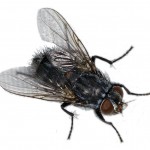Keep Filth Flies Away this Summer
Filth flies transport many food borne pathogens; sanitation and exclusion are critical components of a filth fly management program this summer

Filth flies are one of the most recognizable insects, and because of that familiarity, people tend to have a greater tolerance for them. However, based on their physiology and behaviors, they are exceptionally capable of delivering pathogens. Our response should be the opposite of acceptance as filth flies carry more food borne pathogens than the reviled German cockroach. Flies as a group comprise 12 out of the 22 spots on FDA’s dirty 22 list of pests to avoid near food. In addition to a body equipped with lots of hairs for transporting pathogens, filth flies travel long distances to and from sanitary and unsanitary places. They move from breeding sites such as feces, animal carcasses and garbage receptacles to our tables. They regurgitate and defecate on our food and spread their filth.
As fly season approaches this summer it is time to ready our defenses for controlling these public health menaces. A variety of non-chemical and chemical tools are used in managing these pests. This white paper will provide an update on several methods including chemical controls and mechanical controls such as insect light traps and other tools to consider when putting together a filth fly management program.
Read the full article to learn more information about these controls and how to prevent and exclude filth flies this summer
